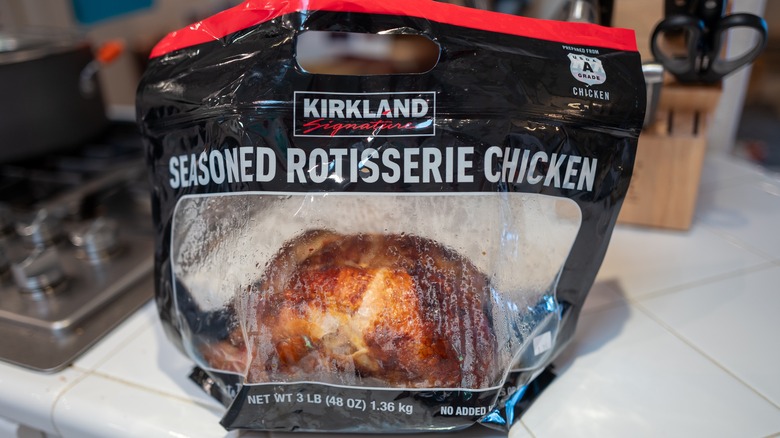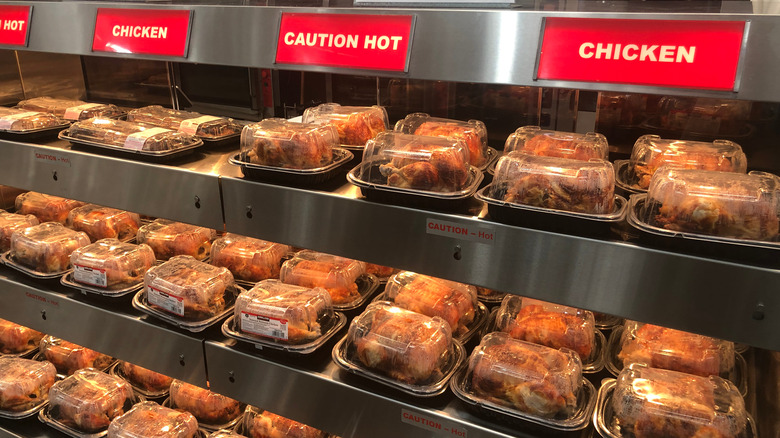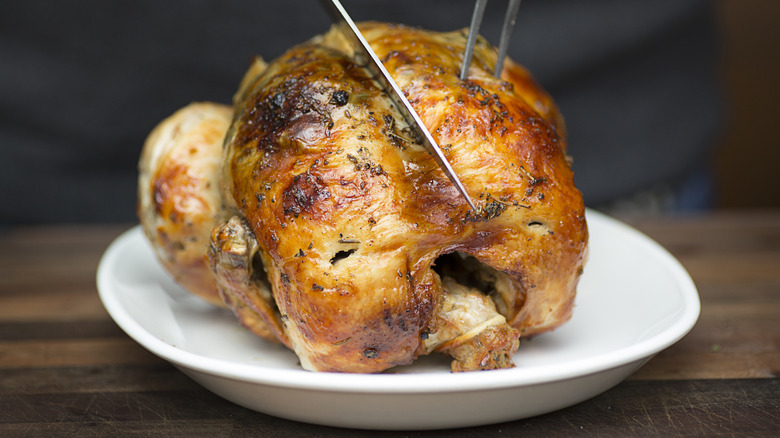Why Costco's Rotisserie Chicken Ditched The Clamshell Container For Bags
Of the approximately 4,000 different products for sale at a Costco warehouse, perhaps the most iconic item of all is the rotisserie chicken. 2024 marks the thirtieth year since the first appearance of this famous roasted bird on the wholesale club's shelves, but it also represents a turning point in history. In spring 2024, Costco executives announced that rotisserie chickens would soon be sold in plastic bags, rather than clamshell containers, at various locations throughout the United States.
The primary motivation for this transition from one form of packaging to another is to reduce the company's impact on the environment. By offering bags instead of clamshells, Costco may cut down on its plastic use by as much as 75%. In this way, the chain could decrease its carbon emissions while lessening its contribution to plastic pollution in our ecosystems and landfills.
For consumers, the smaller size and flexibility of the bags may also offer the advantage of being easier to carry and transport to home kitchens along with the rest of a large haul from Costco; however, some have already complained that the bags are more prone to leaking.
The environmental impact of plastic containers versus bags
Making the change from a plastic container to a plastic bag may seem inconsequential at the level of a single consumer, but when scaled up to the broad reach of a wholesale chain like Costco, this kind of packaging choice has an enormous effect. In 2023, Costco sold 137 million rotisserie chickens. Some plastics take as long as 500 years to decompose, which means that while it may take just a day or two for many of us to polish off one of these chickens, those millions of empty clamshells may remain on our planet much longer than we will.
Months before making the announcement about switching from their classic containers to the new bags, Costco released a statement about developing a set of sustainability practices to reduce packaging across a range of products. Its innovative approach to the rotisserie chicken packaging aims to diminish consumption of resin, a substance obtained by drilling for petroleum, by over 17 million pounds each year.
Safely storing and reheating Costco rotisserie chicken
If you are a long-time member of this wholesale club, you may already know that Costco's rotisserie chickens have a two-hour shelf-life. This company-wide practice is in place to ensure the best quality meat in terms of taste, texture, and food safety. Any chicken that does not fly off the shelf in this short period will get put to use in other Costco products, such as soups and salads.
Since cooked chicken is susceptible to foodborne illnesses caused by bacteria like Salmonella and Listeria, it's extremely important to be attentive to timing and temperature when properly storing this Costco favorite at home. When correctly stored in an airtight container, a rotisserie chicken will last in the fridge for just three to four days, so make sure to prioritize this item over longer-lasting foods when planning your meals after a Costco run.
Once refrigerated, the key to reheating a rotisserie chicken to keep the skin nice and crispy is to use your oven. Make sure the internal temperature of the meat reaches 165 degrees Fahrenheit to reduce any potential health risks.



